智能语音小车软件毕业设计答辩稿
- 格式:ppt
- 大小:372.00 KB
- 文档页数:16
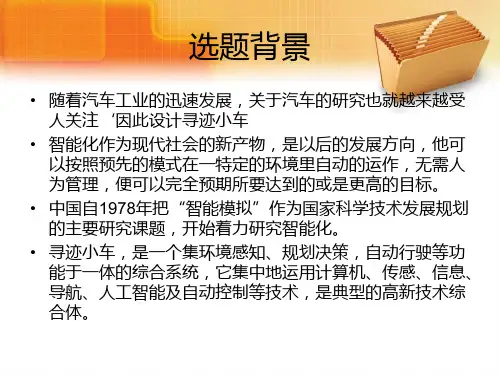

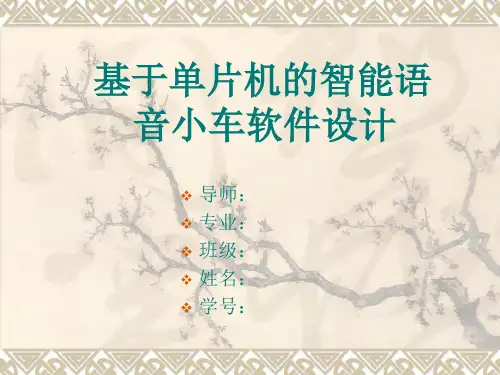

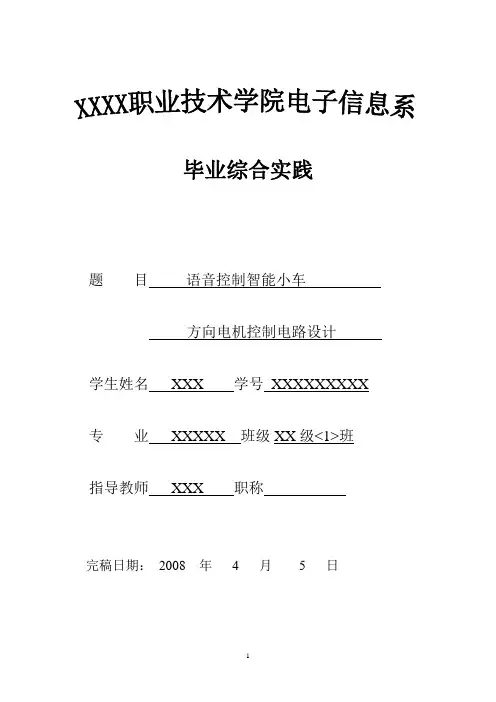
毕业综合实践题目语音控制智能小车方向电机控制电路设计学生姓名XXX 学号XXXXXXXXX 专业XXXXX 班级XX级<1>班指导教师XXX 职称完稿日期:2008 年 4 月 5 日毕业综合实践开题报告工作进度计划(在老师指导下拟定):目录一、引言 (6)二、设计要求 (6)2.1 功能要求: (6)2.2 参数说明 (6)三、特性简介 (6)四、方案介绍 (7)五、系统硬件设计 (8)5.1 车体介绍 (9)5.2 小车的行走原理. (9)5.3 控制板原理图 (10)六、系统软件设计 (10)6.1主程序设计. (10)6.2语音识别的原理简介 (12)七、方向电机控制电路 (12)八、常见问题 (14)九、结束语 (15)附录 (16)参考文献 (17)内容摘要介绍了语音遥控的电动小车的硬件设计部分和使用软件智能控制部分。
语音遥控的电动小车在硬件设计部分采用SPCE061A精简开发板和控制板,在软件智能控制部分,采用语音控制方式,使小车可以“听懂”人的命令,实现小车的前进后退等功能。
控制系统采用的是AT89S51单片机,编程语言使用的是汇编语言,动力系统使用的是伺服马达,能源系统使用的是9V电池。
关键词:SPCE061A软件智能控制硬件设计一、引言语音处理技术是一门新兴的技术,它不仅包括语音的录制和播放,还涉及语音的压缩编码和解码,语音的识别等各种处理技术。
以往做这方面的设计,一般有两个途径:一种方案是单片机扩展设计,另一种就是借助于专门的语音处理芯片。
普通的单片机往往不能实现这么复杂的过程和算法,即使勉强实现也要加很多的外围器件。
专门的语音处理芯片也比较多,如ISD 系列、PM50 系列等,但是专门的语音处理芯片功能比较单一,想在语音之外的其他方面应用基本是不可能的。
SPCE061A 是一款 16 位μ'nSP结构的微控制器。
该芯片带有硬件乘法器,能够实现乘法运算、内积运算等复杂的运算。
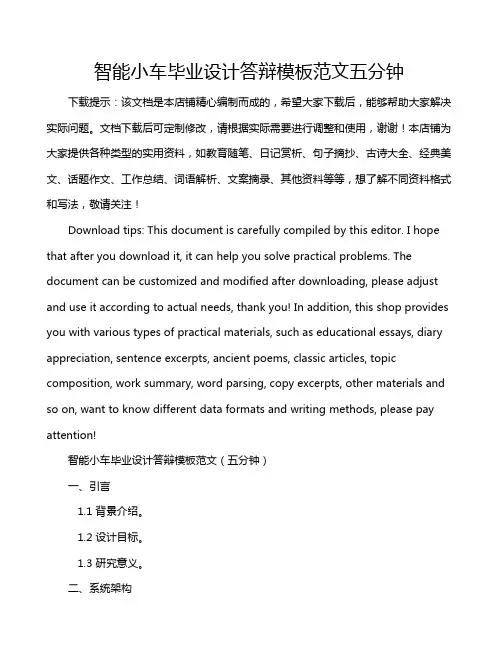
智能小车毕业设计答辩模板范文五分钟下载提示:该文档是本店铺精心编制而成的,希望大家下载后,能够帮助大家解决实际问题。
文档下载后可定制修改,请根据实际需要进行调整和使用,谢谢!本店铺为大家提供各种类型的实用资料,如教育随笔、日记赏析、句子摘抄、古诗大全、经典美文、话题作文、工作总结、词语解析、文案摘录、其他资料等等,想了解不同资料格式和写法,敬请关注!Download tips: This document is carefully compiled by this editor. I hope that after you download it, it can help you solve practical problems. The document can be customized and modified after downloading, please adjust and use it according to actual needs, thank you! In addition, this shop provides you with various types of practical materials, such as educational essays, diary appreciation, sentence excerpts, ancient poems, classic articles, topic composition, work summary, word parsing, copy excerpts, other materials and so on, want to know different data formats and writing methods, please pay attention!智能小车毕业设计答辩模板范文(五分钟)一、引言1.1 背景介绍。

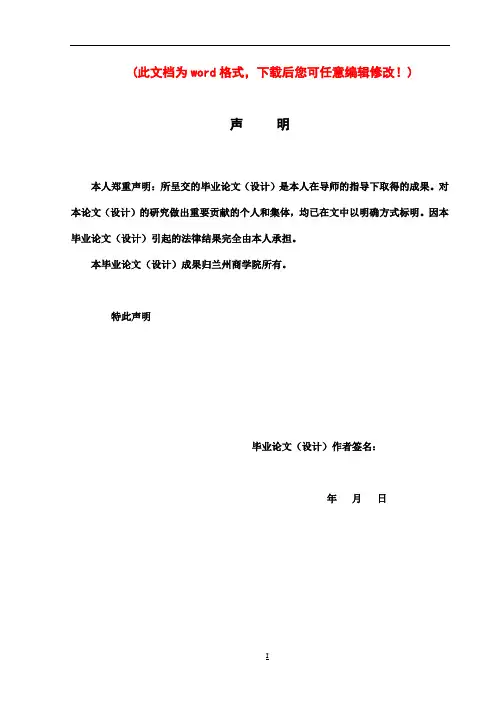
(此文档为word格式,下载后您可任意编辑修改!)声明本人郑重声明:所呈交的毕业论文(设计)是本人在导师的指导下取得的成果。
对本论文(设计)的研究做出重要贡献的个人和集体,均已在文中以明确方式标明。
因本毕业论文(设计)引起的法律结果完全由本人承担。
本毕业论文(设计)成果归兰州商学院所有。
特此声明毕业论文(设计)作者签名:年月日语音识别智能小车摘要本文介绍一款语音识别智能小车的设计。
该小车以SPCE061A为控制核心,可通过语音识别对其行驶状态和控制模式进行控制和切换。
本设计主要完成了各部分硬件模块的设计,同时实现了智能小车的语音识别、语音播放、模式切换、行驶状态控制、无线遥控等功能的软件设计,从而使小车和控制者具有一定的交互功能。
测试表明,小车可以根据控制者的操作做出相应的动作。
[关键词] SPCE061A语音识别无线遥控交互功能ABSTRACTThis paper introduces speech recognition of intelligent car design. The car to SPCE061A as control core, what but through the speech recognition on the operation and control model control and switch. This design main completed each part of the design of the , speech broadcast, mode switch, driving state control, wireless remote control functions of software design, so as to make the car and the controllers interactive function. Tests show that, according to the operation of the car can controller make corresponding action. [Key Words] SPCE061A, Voice control, Wireless module, Interactive function目录一、引言 (1)二、概述和方案论证 (2)(一)控制核心的选择及其简介 (3)(二)小车车体的方案选择 (4)(三)无线接收电路模块和遥控器及简介 (5)(四)避障模块 (5)三、硬件设计 (6)(一)系统电源电路 (6)(二)语音识别电路 (7)(三)语音播放电路 (7)(四)壁障电路 (8)(五)小车车体与驱动电路 (8)1、小车车体结构 (8)2、电机驱动电路 (9)(六)小车总体硬件实物图 (11)(七)PCB的设计 (11)四、软件设计 (12)(一)主程序设计 (12)(二)语音播放子程序设计 (13)五、测试和说明 (15)(一)说明 (15)1、端口定义 (15)2、操作说明 (15)3、命令简介 (15)4、注意事项 (16)(二)测试 (16)六、结论 (16)参考文献 (18)致谢 (19)附录 (20)语音识别智能小车一、引言随着科学技术的发展,电子产品日新月异,自动语音识别技术[8, 10]的应用真正走入了人们的日常生活,声控系统的应用也不再遥不可及,家用电器和玩具的操作,不再需要以遥控器的繁多按键为控制接口,取而代之的是我们平常说话的模式来驱使家用电器和玩具动作,诸如多种智能电器、玩具小车。
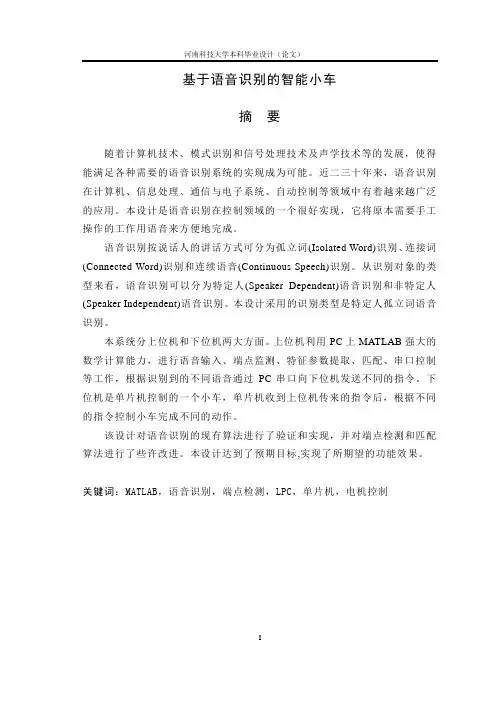
基于语音识别的智能小车摘要随着计算机技术、模式识别和信号处理技术及声学技术等的发展,使得能满足各种需要的语音识别系统的实现成为可能。
近二三十年来,语音识别在计算机、信息处理、通信与电子系统、自动控制等领域中有着越来越广泛的应用。
本设计是语音识别在控制领域的一个很好实现,它将原本需要手工操作的工作用语音来方便地完成。
语音识别按说话人的讲话方式可分为孤立词(Isolated Word)识别、连接词(Connected Word)识别和连续语音(Continuous Speech)识别。
从识别对象的类型来看,语音识别可以分为特定人(Speaker Dependent)语音识别和非特定人(Speaker Independent)语音识别。
本设计采用的识别类型是特定人孤立词语音识别。
本系统分上位机和下位机两大方面。
上位机利用PC上MATLAB强大的数学计算能力,进行语音输入、端点监测、特征参数提取、匹配、串口控制等工作,根据识别到的不同语音通过PC串口向下位机发送不同的指令。
下位机是单片机控制的一个小车,单片机收到上位机传来的指令后,根据不同的指令控制小车完成不同的动作。
该设计对语音识别的现有算法进行了验证和实现,并对端点检测和匹配算法进行了些许改进。
本设计达到了预期目标,实现了所期望的功能效果。
关键词:MATLAB,语音识别,端点检测,LPC,单片机,电机控制SMART CAR GASED SPEECH RECOGNITIONABSTRACTWith the development of computer technology,pattern recognition,signal processing technology and acoustic technology etc, the speech recognition system that can meet the various needs of people is more possible to achieve.The past three decades, the voice recognition in the field of computer, information processing, communications and electronic systems, automatic control has increasingly wide range of applications.Speech recognition by the speaker's speech can be divided into isolated word (Isolated Word) identification, conjunctions (Connected Word) and continuous speech recognition (Continuous Speech) identification. Identifying the type of object from the point of view, the voice recognition can be divided into a specific person (Speaker Dependent) speech recognition and non-specific (Speaker Independent) speech recognition. This design uses the identification type is a specific person isolated word speech recognition.This design is of a good implementation of speech recognition in the control field, it does the work that would otherwise require manual operation by the voice of people easily.This system includes two major aspects:the host system and the slave system. The host system use the MATLAB on the computer which has powerful mathematical computing ability to do the work of voice input, endpoint monitoring, feature extraction, matching, identification and serial control,then it send different commands through the PC serial port to slave system according different recognised voice. The slave system is a car controlled by a single-chip micro-controller.It controls the car do different actions according different instructions received.The design is checking and realization of the existing speech recognition algorithm and I the endpoint detection and matching algorithms were slight improved.This design achieved the expected goals and achieved the desired functional effect.KEY WORDS:MATLAB,Speech Recognition,Extreme Points Test,LPC,Chip Microcomputer,Motor Drive目录前言 (1)第1章系统总体设计方案介绍 (3)第2章上位机设计 (4)§2.1 语音识别简介 (4)§2.1.1 语音识别发展 (4)§2.1.2 语音识别的分类 (4)§2.2 声音录入 (5)§2.3 声音的预处理 (6)§2.3.1 欲加重处理 (6)§2.3.2 分帧处理 (6)§2.4 端点检测 (6)§2.4.1 过零率 (6)§2.4.2 音量 (7)§2.4.3 过零率和音量积谱 (8)§2.4.4 用过零率和音量积谱来检测端点 (9)§2.5 特征参数提取 (10)§2.5.1 特征参数概述 (10)§2.5.2 用MATLAB实现LPC系数的计算 (14)§2.6 语音识别中的模式匹配 (14)§2.6.1 DTW算法原理 (14)§2.6.2 程序实现 (16)§2.7 MATLAB上的GUI设计 (18)第3章下位机设计 (20)§3.1 小车总体设计 (20)§3.1.1 小车总体框图 (20)§3.1.2 小车结构设计 (20)§3.2 小车硬件设计 (20)§3.2.1 单片机电路设计 (21)§3.2.2 驱动电路设计 (23)§3.2.3 稳压电路设计 (24)§3.3 小车软件设计 (24)§3.3.1 主程序流程图 (24)§3.3.2 部分主程序 (25)§3.3.3 底层驱动程序 (27)结论 (29)参考文献 (30)致谢 (31)附录 (32)前言随着计算机技术、模式识别和信号处理技术及声学技术等的发展,使得能满足各种需要的语音识别系统的实现成为可能。

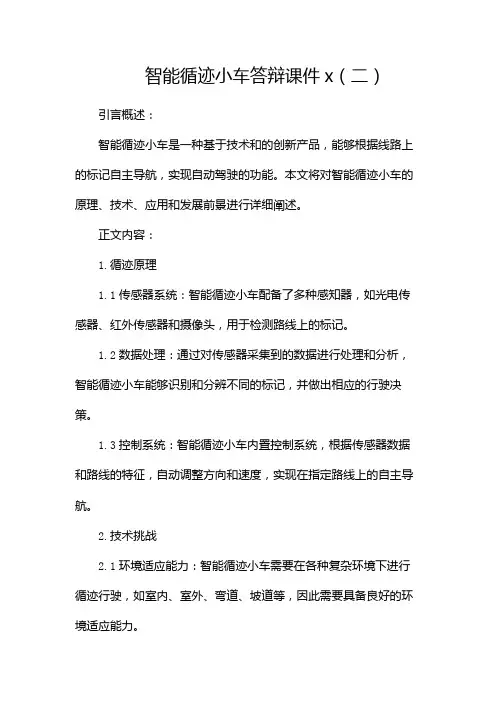
智能循迹小车答辩课件x(二)引言概述:智能循迹小车是一种基于技术和的创新产品,能够根据线路上的标记自主导航,实现自动驾驶的功能。
本文将对智能循迹小车的原理、技术、应用和发展前景进行详细阐述。
正文内容:1.循迹原理1.1传感器系统:智能循迹小车配备了多种感知器,如光电传感器、红外传感器和摄像头,用于检测路线上的标记。
1.2数据处理:通过对传感器采集到的数据进行处理和分析,智能循迹小车能够识别和分辨不同的标记,并做出相应的行驶决策。
1.3控制系统:智能循迹小车内置控制系统,根据传感器数据和路线的特征,自动调整方向和速度,实现在指定路线上的自主导航。
2.技术挑战2.1环境适应能力:智能循迹小车需要在各种复杂环境下进行循迹行驶,如室内、室外、弯道、坡道等,因此需要具备良好的环境适应能力。
2.2高精度定位:为了实现精确导航,智能循迹小车需要具备高精度的定位能力,能够准确识别路线上的标记并进行定位。
2.3鲁棒性和稳定性:智能循迹小车需要能够在不同的路况和工况下保持稳定的行驶性能,并具备一定的鲁棒性,能够应对不可预测的情况。
3.应用领域3.1物流与仓储:智能循迹小车能够在仓储环境中自主导航,实现货物的搬运和分拣,提高物流效率和减少劳动成本。
3.2制造业:智能循迹小车可以应用于生产线上,自动搬运和组装零部件,提高生产效率和质量。
3.3健康医疗:智能循迹小车能够在医院内自主导航,实现药品和样本的运输。
同时,智能循迹小车还可以用于定位和监控病人,提高医疗服务的效率。
3.4家庭服务:智能循迹小车可以应用于家庭环境中,实现自动搬运、清扫和送餐等家庭服务功能,提供便捷的生活体验。
3.5农业领域:智能循迹小车可以用于农业生产中的播种、除草、施肥等任务,提高农业生产效率和减少劳动成本。
4.发展前景智能循迹小车在工业自动化和智能交通领域具有广阔的应用前景。
随着技术的不断进步和成本的降低,智能循迹小车将逐渐普及,并成为人们生活中不可或缺的一部分。